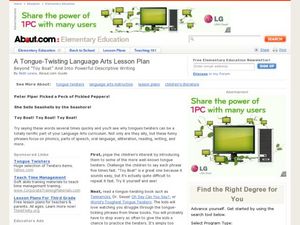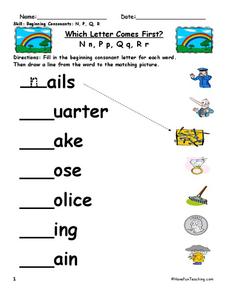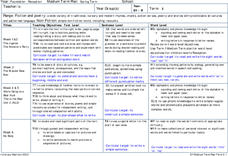Curated OER
A Tongue-Twisting Language Arts Lesson
Young scholars discover enunciation and alliteration by reading tongue twisters in class. In this language arts lesson, students listen and repeat some of the classic childhood tongue twisters along with their teacher. Young scholars...
Curated OER
A Piece of the Puzzle
Discover the process of writing a story by comparing it to a puzzle. Begin by examining a diagram shaped like a puzzle which contains important elements of a story. Learners mix and match the pieces with elements of a story they are...
Curated OER
Give Us A Clue
Learners practice the vowel phonemes ow/ou, oy/oi, ar/a/al, oo/u, air/are/ear, or/ore/oar/war, aw/au/augh/al, ir/ur/er, ear/eer/ere in a game with two to four players. They extend their practice over and over to identify the phonemes in...
Curated OER
Which Letter Comes First
In this language arts worksheet, students match the words with the appropriate picture while deciding which letter belongs at the beginning of each word.
Curated OER
Which Letter Comes First?
In this literacy worksheet, students match the words with the appropriate picture for each one. They also much choose which letter to begin the spelling of the word.
Curated OER
Reading Report
For this reading worksheet, learners draw one scene from a story. Students may also write a description of their drawing on a separate piece of paper.
Curated OER
'Ai' Crossword
In this vowel sound crossword instructional activity, students use the clues to help them complete the crossword puzzle for words that contain the vowel sound 'ai.'
Curated OER
Letter Recognition: D'Nealian Font
In this letter recognition worksheet, students draw lines to match lower case letters to upper case letters, 13 letters total.
Curated OER
I Magic E Decoder
In this spelling codes worksheet, students decode the 'i magic e' words using the decoder box. Students spell and read 30 words.
Curated OER
I Magic E Words
In this spelling codes worksheet, students find the hidden 'i magic e' words in the word search puzzle. Students use the word bank to find the 30 words.
Curated OER
'IGH' Words
In this word search worksheet, students find the hidden 'igh' words in the word search puzzle. Students use the word bank to find the 14 words.
Curated OER
Word Search Puzzle: Rhyming Words That End With -eat or -eet
In this rhyming words instructional activity, students find and circle/highlight twelve rhyming words that end in "-eat" or "-eet" in a word search puzzle.
Curated OER
Word Families
In this word families worksheet, students look at the pictures and words given and write 2 more words to fit into that word family. Students complete 4 problems.
Curated OER
Sentence Structure
Third graders examine good sentence structure and identify the subjects and predicates in a variety of sentences. They read the sentences on a handout and evaluate them for their structure, highlight the subjects and predicates, and...
Curated OER
Poetry & Word Families
Students study a word family before listing rhyming words in that family. They use the words to begin developing lines of poetry. They continue writing poetry individually and finally, they illustrate their work using graphic software.
Curated OER
Match Those Sounds
In this matching of sounds worksheet, students match up the sounds of "sh" and/or "ch" to eighteen pictures. Students fill in the blanks above each picture with a "sh" and/or "ch."
Curated OER
Daily Oral Language Activities: Idioms
Third graders examine the use of idioms. In this vocabulary and reading instructional activity, 3rd graders explore what idioms are and make their own idiom cards to help them understand the use idioms in language.
Curated OER
ESL: Long Vowel Activity
In this ESL long vowel worksheet, students write words for pictures that contain a long vowel sound. Students may click on a sound icon to hear the word if necessary.
Curated OER
Animal Habitats
Learners explore animal lifestyles by researching their characteristics. In this animal habitat lesson, students read the story Over in the Jungle and analyze the animal illustrations in the book. Learners create clay animal characters...
Curated OER
Phonemic Awareness, Say It and Move It
Students clap and count sounds when saying different words. In this phonemic awareness lesson plan, students move bingo chips around when hearing a certain number of sounds in words.
Curated OER
Awesome Spelling
Students are introduced to spelling words as a whole class by viewing a PowerPoint. They spell the word, repeat and spell the word again as a whole class. Pupils create a sentence orally using the list of words. Students work in small...
Curated OER
Titanic
Students conduct research with the purpose of writing a report about the Titanic. They use a variety of resources. The students produce a written document that has plenty of documented information. They also compare the information that...
Curated OER
Fiction and Poetry
Students explore fictional text and poetry. They explore the story structures used in the types of texts and examine the language patterns used. Students practice tracking text in the correct manner.
Curated OER
Flow Charts
Young scholars explore the use of flow charts and cyclical diagrams. They discuss how to read the charts. Students produce a simple flow chart or diagram to explain a process. They investigate various methods used to present text.
Other popular searches
- Teaching Phonics
- Phonics Worksheets
- Phonics Blends
- Phonics Lesson Plans Vowels
- Phonics Lesson Plans
- Phonics Rules
- Phonics Games
- Phonics Worksheets Oi Oy
- Phonics Lessons
- Phonics Activities
- Phonics /Ch/
- Phonics Games Short Vowels

























